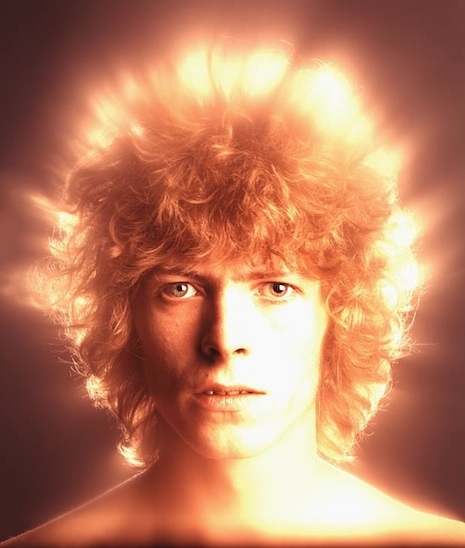
It had to come, it always does and usually when we least expect it. So, it was this morning when news broke of David Bowie’s untimely demise. Even the presenters on television seemed stunned, slightly disbelieving at the words they mouthed off teleprompters. It was unreal—sitting eating breakfast around seven in the morning, still in dressing gown, the world dark outside, when suddenly I heard the news that someone who had been a constant in my life—like a parent or a friend—was gone.
Odd how someone I never met, never knew, only listened to and watched could cause such a sense of inestimable loss.
The release of his albums The Next Day in 2013 and Blackstar ★ last week was further proof that Bowie was beyond mortal and would somehow continue onwards creating his magical works of brilliance. But perhaps, we should have listened more closely to the words he sang:
Look up here, I’m in heaven.
I’ve got scars that can’t be seen.
I’ve got drama, can’t be stolen,
Everybody knows me now…Oh I’ll be free.
Just like that bluebird.
Oh I’ll be free.
Ain’t that just like me.

Though he had just celebrated his 69th birthday, “David Bowie” was really born fifty years ago when he changed his surname from Jones to Bowie. The name change allowed the young 20-year-old to become someone else—something far more interesting than just another aspiring singer and musician hungry for fame. He became whatever ever he wanted to be—a kind of “Everyman” as he later described himself:
I’m Pierrot. I’m Everyman. What I’m doing is theatre, and only theatre. What you see on stage isn’t sinister. It’s pure clown. I’m using myself as a canvas and trying to paint the truth of our time
Theater was always important to Bowie. In December his drama Lazarus co-authored with Enda Walsh “a two-hour meditation on grief and lost hope” was being hailed as a “wild, fantastical, eye-popping” masterpiece. This wasn’t Bowie’s first venture into theater and writing a musical score—his first came in 1967, when Bowie collaborated with the maverick performer, choreographer and director Lindsay Kemp.
It was on 28 December 1967 that David Bowie made his theatrical debut at the Oxford New Theater. He was appearing as Cloud in Lindsay Kemp’s mime Pierrot in Turquoise (aka The Looking Glass Murders). Bowie wrote and performed the songs, while Kemp played Pierrot, with Jack Birkett as Harlequin, and Annie Stainer as Columbine.
The production was in rehearsal when it opened at the New Theater—which may explain why the Oxford Mail described the show as “something of a pot-pourri.” The reviewer did however praise Bowie’s musical contribution:
David Bowie has composed some haunting songs, which he sings in a superb, dreamlike voice. But beguilingly as he plays Cloud, and vigorously as Jack Birkett mimes Harlequin, the pantomime isn’t a completely satisfactory framework for some of the items from his repertoire that Mr Kemp, who plays Pierrot, chooses to present….
...No doubt these are shortcomings Mr. Kemp will attend to before he presents Pierrot in Turquoise at the Prague Festival at the invitation of Marceau and Fialka next summer. No mean honour for an English mime troupe.
The production told the story of Pierrot’s fateful attempts to win the love of Columbine. As we know, the path of true love never runs smooth, and Columbine falls for Harlequin, and is then killed by Pierrot.
After a few tweaks Pierrot in Turquoise opened at the Rosehill Theater, Whitehaven, before going on to the Mercury Theater and Intimate Theater London in March 1968.

Bowie’s career throughout the sixties fits Thomas Edison’s adage “Genius is one percent inspiration, ninety-nine percent perspiration.” He worked hard and continually toured the length and breadth of Britain under various guises: The Konrads, The Hookers, Davie Jones and The King Bees, The Manish Boys, the Blues influenced Davie Jones and The Lower Third, Davie Jones and The Buzz, and The Riot Squad, a band described as:
The Complete Musical Entertainers covering Pop, Tableaux, Burlesque and Parody
Even at this early stage Bowie was shedding musical styles quicker than he changed his haircut—from beat thru blues to music hall and pop. With hindsight it is possible to see where his career was going but by 1967 the teenager’s recording career had come to a halt after he released the unsuccessful novelty song “The Laughing Gnome.” Bowie didn’t release a record for another two years.
It was during this time that Bowie fell under the influence of mime artist and performer Lindsay Kemp, who helped Bowie channel his unique talent towards “Space Oddity” and later Ziggy Stardust. As Kemp later told journalist Mick Brown for Crawdaddy in 1974:
“I taught David to free his body,” says Kemp, smiling wickedly.
“Even before meeting, David and I had felt the need to work together. I’d identified myself with his songs, and he’d seen my performances and identified himself with my songs. I was singing the songs of my life with my body; he was singing the songs of his life very fabulously with his voice, and we reckoned that by putting the two together the audience couldn’t help but be enthralled. In other words, one large gin is very nice, but two large gins are even nicer.”
The two large gins became Pierrot in Turquoise, which (thankfully) was filmed by Scottish Television in 1969 and then broadcast in July 1970. How a small regional TV station like STV came to film this wonderful treat is probably a tale in itself—even if one cataloguer described the production as “quite creepy.”
The cast:
David Bowie as Cloud
Lindsay Kemp as Pierrot
Jack Birkett as Harlequin
Annie Stainer as Columbine
Michael Garrett as Piano Player
Filmed at the Scottish Television’s Gateway Theater, in Edinburgh, directed by Brian Mahoney.